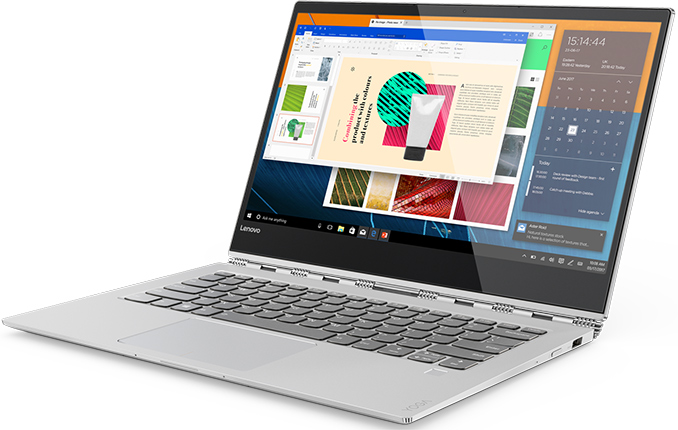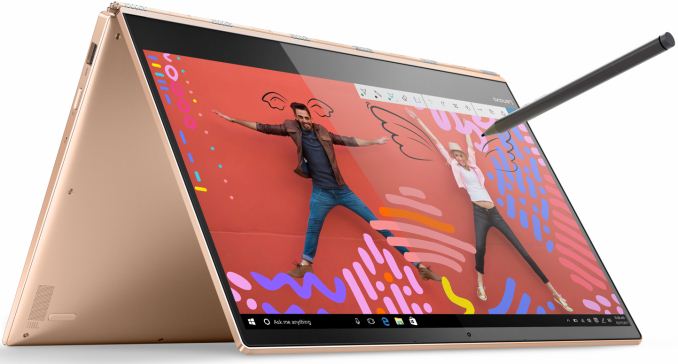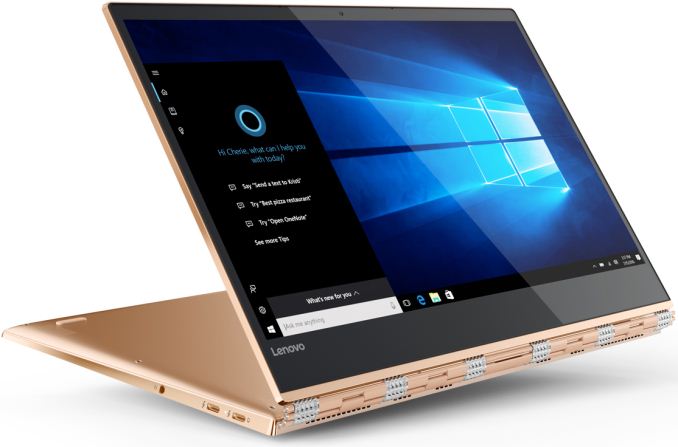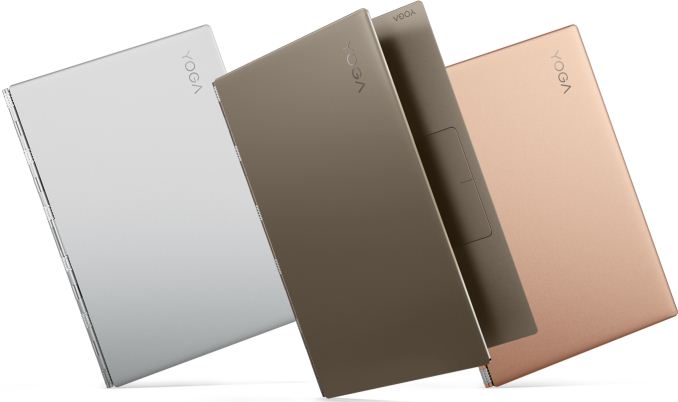Lenovo Launches Yoga 920 Convertible: 13.9” 4K LCD, 8th Gen Core i7, TB3, 3 Pounds
by Anton Shilov on September 2, 2017 3:00 PM EST
Lenovo this week announced its new Yoga 920 convertible laptop that became more powerful due to Intel’s upcoming 8th generation Core i-series CPUs with up to four cores, better connected thanks to two Thunderbolt 3 ports, yet slimmer than its predecessor. The new model inherits most of the peculiarities of the previous-generation Lenovo Yoga 900-series notebooks and improves them in various ways.
The new Lenovo Yoga 920 is the direct successor of the Yoga 2/3 Pro, Yoga 900 and the Yoga 910 convertible laptops that Lenovo launched in 2013 – 2016. These machines are aimed at creative professionals, who need high performance, 360° watchband hinge, touchscreen, reduced weight and a long battery life. Over the years, Lenovo has changed specs and design of its hybrid Yoga-series laptops quite significantly from generation to generation in a bid to improve the machines. This time the changes are not drastic, but still rather significant both inside and outside.
The new Lenovo Yoga 920 will come with a 13.9” IPS display panel featuring very thin bezels and either 4K (3840×2160) or FHD (1920×1080) resolution, which is exactly the same panel options that are available for the Yoga 910. In the meantime, Lenovo moved the webcam from the bottom of the display bezel to its top. Besides, it reshaped the chassis slightly and sharpened its edges, making the Yoga 920 resemble Microsoft’s Surface Book. Changes in external and external design of the new Yoga vs. the predecessor enabled Lenovo to slightly reduce thickness of the PC from 14.3 to 13.95 mm (0.55”) and cut its weight from 1.38 kilograms to 1.37 kilograms (3.02 lbs).
Internal differences between the Yoga 920 and the Yoga 910 seem to be no less significant than their external designs. In addition to the new Core i 8000-series CPU (presumably a U-series SoC with up to four cores and the HD Graphics 620 iGPU), the Yoga 920 also got a new motherboard that has a different layout and feature set. The new mainboard has two Thunderbolt 3 ports (instead of two USB 2.0/3.0 Type-C headers on the model 910) for charging, connecting displays/peripherals and other things. In addition, the new mobo moves the 3.5-mm TRRS Dolby Atmos-enabled audio connector to the left side of the laptop. Speaking of audio capabilities, it is necessary to note that the Yoga 920 is equipped with two speakers co-designed with JBL as well as with far field microphones that can activate Microsoft’s Cortana from four meters away (13 feet). As for other specifications, expect the Yoga 920 to be similar to its predecessor: up to 16 GB of RAM (expect a speed bump), a PCIe SSD (with up to 1 TB capacity), a 802.11ac Wi-Fi + Bluetooth 4.1 module, a webcam, as well as a end-to-end encrypted Synaptics fingerprint reader with Quantum Matcher compatible with Windows Hello.
The slightly thinner and lighter chassis as well as different internal components made Lenovo to reduce capacity of Yoga 920’s battery to 66 Wh from 79 Wh, according to TechRadar. When it comes to battery life, LaptopMag reports that it will remain on the same level with the previous model: 10.8 hours on one charge for the UHD model and up to 15.5 hours for the FHD SKU.
| Lenovo Yoga Specifications | ||||
| Yoga 900 | Yoga 910 (up to) |
Yoga 920 (up to) |
||
| Processor | Intel Core i7-6500U (15W) | Intel Core i7-7000 series | Intel Core i7-8650U | |
| Memory | 8-16GB DDR3L-1600 | Up to 16 GB | ||
| Graphics | Intel HD 520 (24 EUs, Gen 9) |
Intel HD Graphics 620 | ||
| Display | 13.3" Glossy IPS 16:9 QHD+ (3200x1800) LED |
13.9" 4K (3840 x 2160) IPS 13.9” FHD (1920x1080) IPS |
||
| Hard Drive(s) | 256GB/512GB SSD (Samsung ?) | Up to 1 TB PCIe SSD | Up to 1 TB PCIe 3 x4 SSD Samsung PM961 |
|
| Networking | Intel Wireless AC-8260 (2x2:2 802.11ac) | 2x2:2 802.11ac | ||
| Audio | JBL Stereo Speakers Dolby DS 1.0 TRRS jack |
JBL Stereo Speakers with Dolby Audio TRRS jack |
JBL Stereo Speakers with Dolby Atmos TRRS jack |
|
| Battery | 4 cell 66Wh | 79 Wh | 66 Wh | |
| Buttons/Ports | Power Button 2 x USB 3.0-A 1 x USB 3.0-C Headset Jack SD Card Reader DC In with USB 3.0-A Port |
Power Button 1 x USB 3.0-A 1 x USB 3.0-C 1 x USB 2.0-C for charging Headset Jack |
Power Button 1 x USB 3.0-A 2 x Thunderbolt 3 Headset Jack |
|
| Back Side | Watchband Hinge with 360° Rotation Air Vents Integral to Hinge |
|||
| Dimensions | 12.75" x 8.86" x 0.59" 324 x 225 x 14.9 mm |
12.72" x 8.84" x 0.56" 322 x 224.5 x 14.6 mm |
13.95 mm (0.55”) thick | |
| Weight | 2.8 lbs (1.3 kg) | 3.04 lbs (1.38 kg) | 3.02 lbs (1.37 kg) | |
| Extras | 720p HD Webcam Backlit Keyboard |
|||
| Colors | Platinum Silver Clementine Orange Champagne Gold |
Platinum Silver Champagne Gold Gunmetal |
Silver Bronze Copper |
|
| Pricing | $1200 (8GB/256GB) $1300 (8GB/512GB) $1400 (16GB/512GB) |
Starting from $1299 | Starting from $1329 | |
Lenovo will offer an optional Lenovo Active Pen 2 with 4,096 levels of pen sensitivity with its Yoga 920. The stylus will cost $53 and will enable people to draw or write on the touchscreen.
The Lenovo Yoga 920 convertible laptops will be available in silver, bronze and copper colors later this year starting from $1329 (a slight price bump over the predecessor). By contrast, the Yoga 910 came in silver, gold and dark grey (which the manufacturer called gunmetal).
Related Reading:
- Lenovo Reveals Yoga 910 Convertible: Intel’s Kaby Lake Meets 4K Display and Ultra-Thin Form-Factor
- The Lenovo Yoga 900 Series Launched: The ‘Thinnest’ Core Laptop and a 27-inch Portable All-In-One
- Lenovo’s Yoga Book Convertible Scraps Physical Keyboard in Favor of Touch-Sensitive Surface
- Lenovo Yoga Tab 3 Plus: Snapdragon 652, 10-Inch 2K Display, JBL Speakers and USB-C
- Lenovo Updates The X1 Lineup: Thin Bezel X1 Carbon, X1 Yoga And X1 Tablet Updates
- The Lenovo ThinkPad X1 Yoga Review: OLED and LCD Tested
Source: Lenovo





















36 Comments
View All Comments
danwat1234 - Sunday, October 15, 2017 - link
dwbogardus,sorry, that's not possible. Those lithium battery packs should be dead after 10 years. Unless stored in a fridge the entire time. Automotive electric car batteries are an entirely different story. But 15 year old consumer cells were not that good...ddriver - Saturday, September 2, 2017 - link
There is a peak to every technology. Nothing scales indefinitely.Take the wheel for example - there has been zero improvement to its shape for thousands of years.
sonny73n - Sunday, September 3, 2017 - link
I'm sorry, sir. I'm not talking about the battery's shape. And the wheel today is much more efficient in every aspect than the wheel invented thousands of years ago.The first Lithium Ion battery was first commercially produced in 1991 based on the invention of Lithium battery tech in the 70's. And this type of battery we're still using in most of our mobile devices today - the year 2017. Of course, there's been a little improvement of this technology but still. I often wondered if there is a new battery tech but our government has kept it for themselves as military secret. Then I remembered thru the history of human that every time we invented something, especially in energy sector, the first thing we did was to use it to manipulate the lives of others, often killing them in masses. Take nuclear energy for an example.
After all that said, I still believe that mobile device manufacturers can work with what we have. I wish they drop the obsession for thinness and expand the battery's capacity because every time I use my phone, my most worries is the battery life, more than dropping the phone and break it. Lenovo can pack a punch in this Yoga but it makes little sense if it won't run for long. Plug it in you say? Well, if I love to hug the wall frequently, I would buy a desktop instead.
If they could just get on with Metal Oxides already.
ddriver - Sunday, September 3, 2017 - link
The functional part of the wheel is the shape. You are making silly parallels, because I wasn't talking about the battery shape neither. Today we have better materials, but wheels are still round, as they were and always will be. It just doesn't get any better than a circle. That's the peak, the optimum.There are numerous examples of technology or process that hasn't improved a bit in a long time.
The media has at least 2-3 articles every year about amazingly promising battery technologies, and has had those for many, many years, yet we still keep using the same batteries. The lead-acid rechargeable battery is now like 150 years old, yet it is still in active use.
And it is not that there aren't viable alternatives, but the industry in its essence is really not all that keen on innovating, they are keen on making money and blowing barely incremental improvements as a big deal. They will keep pushing li-ion even at the face of the hazard it has become in the recent years, like always, they will milk that cow until its dead, and if the milk comes out stale, they will just add artificial sweetener and pass it for cream. They won't build the new fabs required for new battery technology until lithium becomes commercially inviable.
I am not a big fan of thin, but most people are idiots who go for the fad, with little concern for efficiency or usability. It has to look sleek, so buying it can get them perceived self worth. I would LOVE a 1 inch convertible with more processing power, rugged build and a humongous battery. I don't care about the extra weight, I am not anorexic. But nobody makes those, not good ones in any case, as useful as it may be, it is just not trendy. Thicker devices today don't come with better specs and more battery, on the contrary, they come underpowered, because they are "cheap", because they are not thin. They don't fill the extra volume with battery or components, they fill it with shitty design and poor build quality. The yoga 500 is almost an inch thick, but comes with a measly dual core and miserable 5 hours of battery life. Even thou it has a full kilo, 2 inches of size and half an inch of thickness on the yoga 910 it comes with almost half the battery capacity. Because fads matter the most!
WorldWithoutMadness - Sunday, September 3, 2017 - link
because packing dense energy to a small container means a lot of 'fool proof' safety to be taken care of. Otherwise, it's gonna be more kaboom than note's fiasco.Hurr Durr - Saturday, September 2, 2017 - link
This hinge thing istruly hideous.damianrobertjones - Saturday, September 2, 2017 - link
In your opinion.Hurr Durr - Saturday, September 2, 2017 - link
My opinion is all that matters.TesseractOrion - Saturday, September 2, 2017 - link
Nothing you have ever said or thought has mattered.HStewart - Sunday, September 3, 2017 - link
This is cool looking note book and having 4 cores in a 15w 2in1 core is really cool but my major concern is quality of Lenovo. Now if dell could put this cpu in body like the XPS 13 2in1 it would be awesomeI have a Levono y50 and it has quad core and Nvidia GPU, but is heavy, I also have the Dell XPS 13 2in1 and portability is awesome. I just can't wait to see wharf tel does with 8th generation mobile cups in more powerful mobile cpu lines. What makes the y50 be load is probably the GPU but unless you are into games or professional graphics, you don,t need such GPU power.
I dealt with computer industry since the original IBM PC and industry is changed - the days of me making my machines are over - mobile has taking over - these 8th generation cpu I believe are just the tip of ice burg what is coming